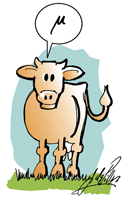History of Science�Lite
July 23, 2010

Courtesy of John de Pillis
Philip J. Davis
Science: A Four Thousand Year History. By Patricia Fara, Oxford University Press, New York, 2009, 432 pages, $34.95.
Years ago, I heard of a man who, no matter what sort of technical book he came across, always looked in the index to see whether he was listed. I confess to a similar failing with respect to the topic of mathematics. I must report at once that it is a pretty anemic "Queen of the Sciences" (in Gauss's phrase) that emerges from the pages of the book under review. More about this shortly.
A writer who proposes to cover the whole of science, from Pythagoras to DNA, simultaneously excites my admiration for nerve and raises my eyebrows for the limitations of the inevitable broad-brush treatment. But nothing ventured, nothing gained, and it would not surprise me to learn that someone out there is currently working on a Complete History of Civilization from Amoeba to Obama.
Accompanied by publicity and hoop-la---videos on YouTube, etc.---that might make many popularizers jealous, Patricia Fara, Fellow of Clare College, Cambridge, and historian of science, has produced a solid history of science served up with scholarly precision. The reader can indeed learn about Robert Hooke's equipment and about the controversies surrounding Sigmund Freud's "id." I, pretty much hidebound by my focus on mathematics and physics, learned a great deal. I knew nothing about Pieter Camper, Henrietta Levitt, Ibn Sina, John Snow, John Ray, Etienne Malus, Shen Gua, or Francis Hauksbee. Now I do know something and, for a brief moment, will be able to attach to each of these names a scientific accomplishment.
Four thousand years in four hundred pages? Not possible, really: Nice try but no cigar. What's been left out? Well, for one thing, as I have already indicated, mathematics is given short shrift, downplayed. Did the invention of logarithms feed into the moon landing? Did numerical methods for differential equations lead to the concept of the butterfly effect? Did the work of Archimedes on spirals lay groundwork for DNA theory? Even before the birth of the electronic digital computer, our everyday world had been increasingly mathematized. Newton is mentioned, of course, and Laplace. Poor Gauss barely slips between the covers with his normal distribution. Galton and Florence Nightingale are present with their statistical techniques. But no Euler, Riemann, or Poincar�. Turing is well represented, but G�del is not. It's author's choice all the way---if you want these and others included, write your own book.
Using a term from Hollywood musicals, I would call some of what Fara gives us "production numbers." For three pages she has great fun tossing around Mesmer and mesmerism. The natural scientist Alexander von Humboldt gets eight pages, and this includes the human touch: "Ecuador's Chimborazo [was] the site of Humboldt's personal glory---after nearly reaching its peak, he boasted that he climbed higher than any other man." Seven pages are allotted to John Dee, a very interesting fellow: a mathematician, astrologer, alchemist, occultist, diviner, and occasional consultant to Queen Elizabeth I of England. It was largely Dee who was responsible for what British historian Frances Yates described as the "Rosicrucian Enlightenment."
In seven pages devoted to Joseph Needham, the famous historian of Chinese science, Fara reformulates a vital question posed by Needham. His "crucial question is not �Why did science develop in western Europe?' but �How did European activities lead to the form of science that now dominates the entire world?'" However, she misses a question that Needham agonized over, one that interests historians of mathematics: How is it that the Chinese, who produced so much interesting mathematics, some of it in advance of Western mathematics, missed out on axiomatics and proof?
Fara has an individual sense of taxonomic arrangements. She labels the book's seven major chapters as follows: Origins, Interactions, Experiments, Institutions, Laws, Invisibles, and Decisions. Within each chapter are seven sections; the first section of the first chapter, called "Sevens," discusses a variety of sevens that occur in science: the five classical planets, the sun, and our moon that together make seven; the seven colors of the rainbow, and so forth. But seven sevens? Is this a numerological obsession or merely a sly and pixie criticism of a methodology that is still alive and occasionally productive?
This, then, is not your standard, often dull, "Look, Ma, ain't science wonderful?" kind of book. What certainly makes it unique is its tonality, its mix of skepticism, satire, irony, parody, suspicion, and feminism in various proportions. There is more joy in Fara-ville with putdowns than with praise, with descriptions of failures than of successes. Despite---or perhaps because of---its underlay of Voltairean laughter, Fara has produced a text that is highly readable, engaging, and in places even effervescent.
Fara is an ironist: "Lord Rayleigh apparently cleared his scientific apparatus off the top of the piano every day to make way for family prayers." She is a debunker: "Scientific icons are worshipped as other-worldly beings who float above the realities of daily life." Or: "Linnaeus' system prevailed not because it was inherently right but because he persuaded naturalists that it was the most convenient." She is a reporter: "Genetics became international big business." She is a skeptic with a strong desire to make points: Scientists, she asserts, even great scientists, often massage their results to confirm what they want to believe.
Speaking of "money hungry inventors," Fara reminds us that profit and personal and national rivalries are only a few of the wide variety of goals that motivate scientists and technologists. Her agenda is to desacralize the Sacred Cow that science has become, and to see it as a human enterprise "with warts and all"---a not unworthy goal.
Philip J. Davis, professor emeritus of applied mathematics at Brown University, is an independent writer, scholar, and lecturer. He lives in Providence, Rhode Island, and can be reached at [email protected].

